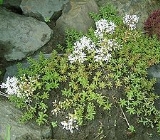
Sedum album
Encyclopedia
Sedum album or White stonecrop, is a flowering plant
of the genus Sedum
in the family Crassulaceae
. Sedum album is able to acclimate according to the environment. The left plant below, grew on top of the wall and therefore had access to less water and fewer nutrients; the right plant however grew at the bottom of the wall and therefore had greater amounts of water and nutrients. The plant at the bottom was therefore able to grow faster. The plant on top of the wall may be red due to plant lacking water and therefore having to synthesise carotenoids to protect it from photoinhibition
. Sedum album is also able to switch between C3 carbon fixation
and crassulacean acid metabolism
(CAM) depending on the availability of water. CAM saves water as the stomata only open to allow to diffuse into the leaves at night when the temperature (and therefore evaporation) is lower.
Flowering plant
The flowering plants , also known as Angiospermae or Magnoliophyta, are the most diverse group of land plants. Angiosperms are seed-producing plants like the gymnosperms and can be distinguished from the gymnosperms by a series of synapomorphies...
of the genus Sedum
Sedum
Sedum is a large genus of flowering plants in the family Crassulaceae, members of which are commonly known as stonecrops. It contains around 400 species of leaf succulents that are found throughout the Northern Hemisphere, varying from annual and creeping herbs to shrubs. The plants have...
in the family Crassulaceae
Crassulaceae
Crassulaceae, or the orpine family, are a family of dicotyledons. They store water in their succulent leaves. They are found worldwide, but mostly occur in the Northern Hemisphere and southern Africa, typically in dry and/or cold areas where water may be scarce...
. Sedum album is able to acclimate according to the environment. The left plant below, grew on top of the wall and therefore had access to less water and fewer nutrients; the right plant however grew at the bottom of the wall and therefore had greater amounts of water and nutrients. The plant at the bottom was therefore able to grow faster. The plant on top of the wall may be red due to plant lacking water and therefore having to synthesise carotenoids to protect it from photoinhibition
Photoinhibition
Photoinhibition is light-induced reduction in the photosynthetic capacity of a plant, alga, or cyanobacterium. Photosystem II is more sensitive to light than the rest of the photosynthetic machinery, and most researchers define the term as light-induced damage to PSII...
. Sedum album is also able to switch between C3 carbon fixation
C3 carbon fixation
carbon fixation is a metabolic pathway for carbon fixation in photosynthesis. This process converts carbon dioxide and ribulose bisphosphate into 3-phosphoglycerate through the following reaction:...
and crassulacean acid metabolism
Crassulacean acid metabolism
Crassulacean acid metabolism, also known as CAM photosynthesis, is a carbon fixation pathway that evolved in some plants as an adaptation to arid conditions. The stomata in the leaves remain shut during the day to reduce evapotranspiration, but open at night to collect carbon dioxide...
(CAM) depending on the availability of water. CAM saves water as the stomata only open to allow to diffuse into the leaves at night when the temperature (and therefore evaporation) is lower.

